The creation of the medicinal plant garden in the Siekopai village of Sewaya is much more than a typical story of an indigenous community’s attempt to consolidate and propagate important medicinal plants. Beyond the garden’s crooked rows of shrubs, vines, grasses, herbs, trees and epiphytes, is the story of two Siekopai youth, brought up amidst the precarious frontier of two wildly different worlds; the world of a deep and diverse forest filled with ancestral knowledge, and an outside word of modernity and technology, threats and opportunity. Compelled by an inspired instinct to adapt how knowledge is passed on, the youth merge these worlds through social media and web pages. In the process, they have been able to inspire a sense of pride and kindle a growing curiosity among the Siekopai youth to further explore the profound knowledge of the last living elders who still heal with plants and quietly practice the ancient ways of life in the Amazon.
The Siekopai people, often referred to as Secoya, are a small Upper Amazonian indigenous tribe (approx. 1500 people) of the Western Tukanoan language family. Residing along the lowland rivers of eastern Ecuador and northern Peru, the Siekopai’s recent history has been an all too common one of a forest people who barely survived the diseases of colonial contact in the 17th century, and who have lived on a frontier of constant resource extraction that has ranged from the exploitation of rubber and other tree gums in the early 1900’s to tree-based perfumes and essential oils jaguar and otter pelts; precious tropical hardwoods; petroleum and gold extraction; and most recently, landscape-level transformation into African oil palm and other mono-crops.

Siekopai dressed in traditional tunic garment and playing bamboo flute during an annual festival.
And yet, despite all of this, the Siekopai have maintained much of their remarkably rich culture, their language-Pai Koka, their music, their ceremonies, their traditional garments, and their critical dependence on vast stands of primary forest for the collection of food and materials used in everyday life. But perhaps most notably, their vast treasury of plant-use knowledge. Dr. Carlos Cerón, a renowned Ecuadorian ethnobotanist, published a study documenting the specific names and uses of more than 1000 plants still used by the Siekopai. These plants were registered over the course of only a handful of field excursions, leaving much of their knowledge hidden from the public. Among the more widely known plants are the Ayahuasca vine (Banisteriopsis caapi), a hallucinogen used by shamans during healing ceremonies; Quinine (Cinchona officinalis), used to cure millions of people with malaria; and Curare (Strychnos toxifera), a vine that provides the chemical base for a muscle relaxant in nearly every surgical procedure.
Recent decades of colonial and industrial encroachment have introduced roads to this region; and with them, cities and western medicine. As a result, the customary use of plants for everyday ailments is slowly being replaced with the convenience of pharmaceuticals in the form of capsules, pills, injections and syrups handed out at local health clinics. Thousands of years of indigenous investigation, experimentation and accumulated knowledge is in peril of disappearing forever.
In an effort to save their last remaining plant knowledge, the village of Sewaya began a garden to host the most important medicinal plants—a place for villagers to conveniently harvest and prepare medicines, as well as a place for learning. A handful of elders began trekking the forest paths, digging up plants, taking cuttings, removing epiphytes from the canopy, and carrying them back to the village in hand-woven shoulder bags. The planting continued for days, but it was obvious that something was missing… the youth.
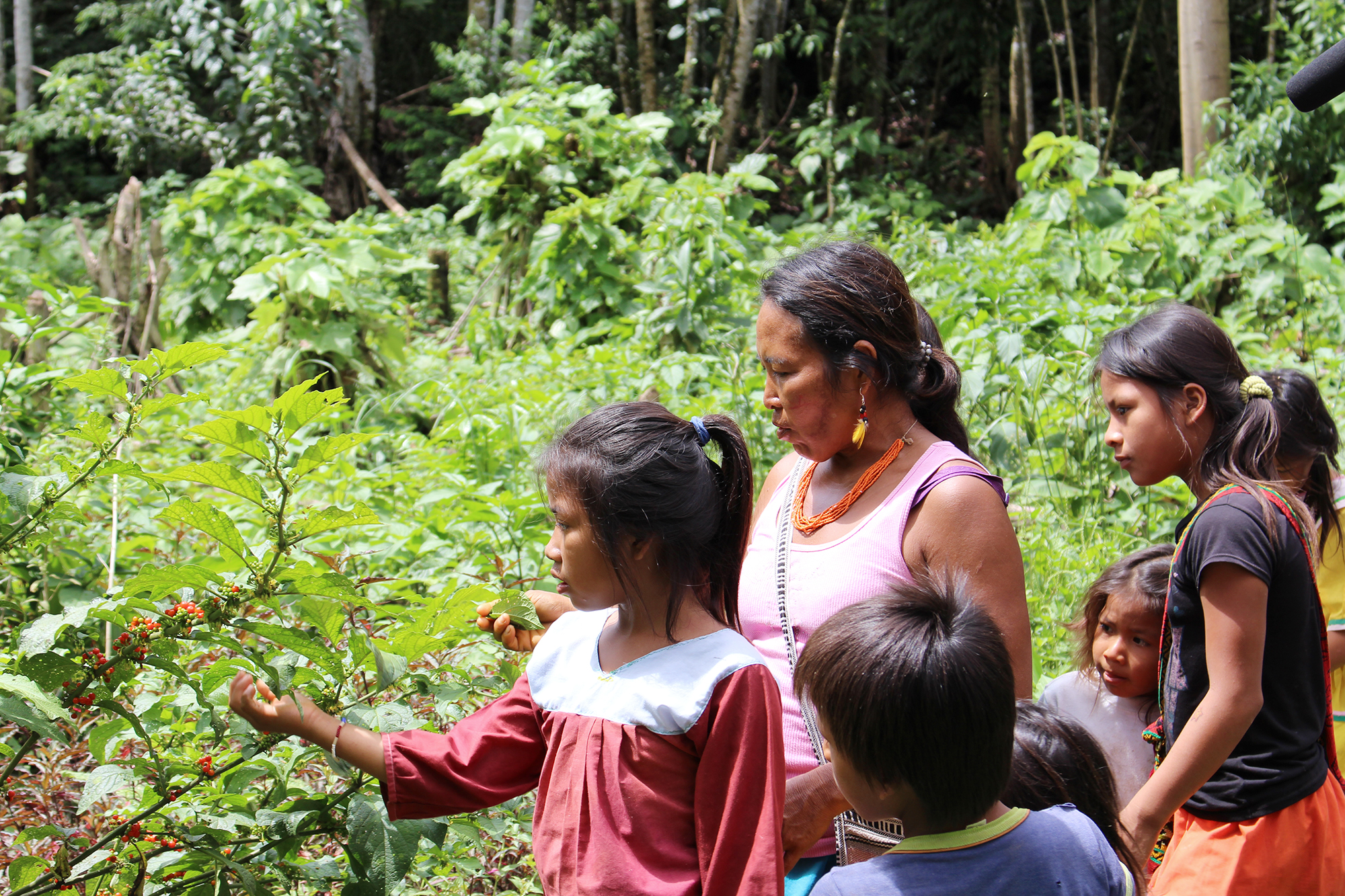
Fanny Payaguaje, the garden curator, guides a group of school children through the medicinal plant garden and points out a common, red-berry “weed” used to treat skin funguses—one of the most common ailments for children in this moist, tropical rainforest.
Frustrated with the lack of participation of their generation, and sensing a fleeing opportunity, 22 year-old Jimi Piaguaje and his 19 year-old cousin Ribaldo Payaguaje set out to invigorate the plant medicine recovery process through the production of documentary video clips. But their idea went beyond that of simply recording the information and saving it on external hard drives for future use. As Jimi says, “Times have changed…most youth no longer spend long days with their parents and grandparents hunting and fishing and learning about the plants along the way… many of us spend the week in nearby cities at school…most of what we really learn comes off laptops and smart phones, and what gets shared on Facebook posts and YouTube.”
Recently trained in videography and film editing, Jimi and Ribaldo began to tag along the small group of elders during their plant collection outings -marking the beginning of what would be their most intensive plant learning experience of their lives. Their first mission was to collect Mañapë, a small understory tree in the Bignoniaceae family, whose beet-red root is used as a cleansing purgative. They headed to the highland forest or terra firma, a forest type noted by the rolling hills, red-clay soils, open ground story, and the wonderful canopy chorus of tucans, screaming peehaw, and cicadas.
An elder revealed the plants’ critical features for identification including dark green, tri-foliate compound leaves with swollen basal stem nodes, and an elbow-like bend in the stem just above the ground. Most importantly, a scrape at the base of the stem with his machete reveals a deep purple color. Roberto, Jimi’s father, explains that dark purple is indicative of the “male” plant, proper for drinking, while a lighter red is the “female” plant which is not drank.
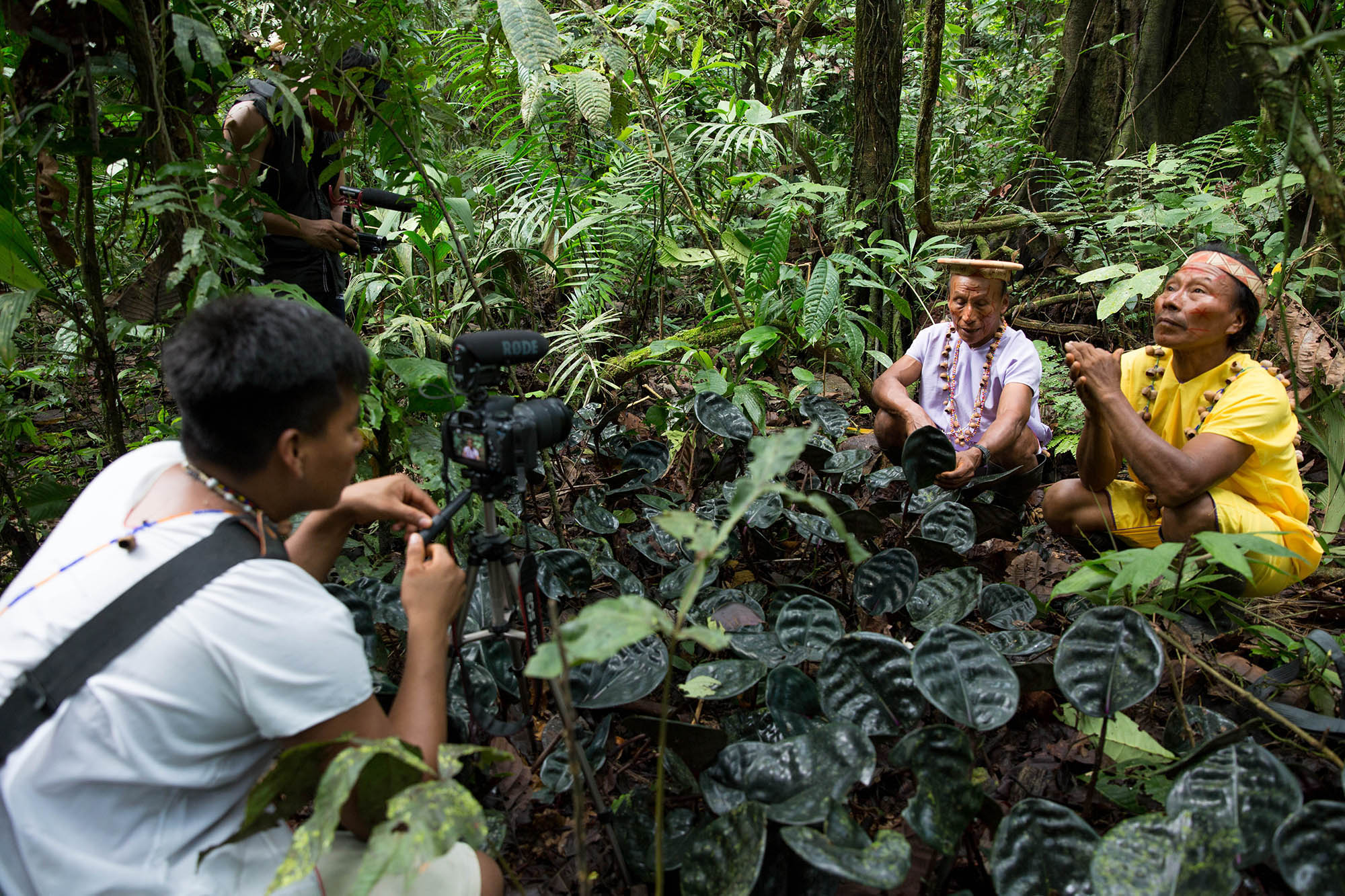
Jimi Piaguaje (front) and Ribaldo Payaguaje document the use of Yai Kajoro (Jaguar’s ear) with their respective fathers Roberto Piaguaje and Gilberto Payaguaje. The plant is used to cure many ailments that affect the liver, such as hepatitis.
The youth filmed the roots being washed in a stream, the dark-red outer layer of the roots rasped with a knife, and then bundled up in a large leaf and carried back home. That evening Jimi and Ribaldo learn the preparation of the root. They carefully observe as 3-4 gourds of pristine water are added to a pot for each participant and placed to boil for several hours in a large cauldron. At 4 am the village shaman raps loudly on the large pot with a metal spoon to awaken the village members and to energize the medicinal brew. Still warm, liter-size gourds of the crimson drink are given a bless-filled blow and passed out to each person.
The elder guide gives instructions: “breath slowly and gulp deeply into the grimy depths of the belly”, and then shares an ancient story. He tells of an adolescent girl who had gone awry, she was without scruples, used vulgar language, told perverted jokes, talked back to her parents and the elders, and in general, approached life without reserve or respect for others–a selfish sort described in Paikoka as “sëome” literally translated as “a tangled mess of string”. The elder continues: “They prepared Manapë for her, and the entire family, just as we have tonight, and she was given several bowls, she drank quickly and soon she vomited intensely and defecated profusely…vomiting and vomiting until finally, exhausted, she sat quietly on a stool reflecting deeply… she began to cry and ask the forgiveness of her mother, family and villagers, in tears she explained how the drink allowed her to see herself, her ways, and how she is connected to and affects others…she heard the counseling of the blood-soaked Jaguar Mother of the Mañapë plant”.
The following day, after recovering from their intense purging experience, Jimi and Ribaldo are summoned to collect Kujisë’së– a plant also of the Piperaceae family- employed as a sort of ancient fluoride treatment to galvanize teeth from decay. The elders explain that the day after a heavy purging is the most effective time for the treatment. The leaves, stems and roots of the plant are boiled in a small amount of water and the brew is swished in the mouth profusely for several minutes. They also learn its use to properly cleanse women’s mouths before the masticating of manioc root during the fermentation of chicha.
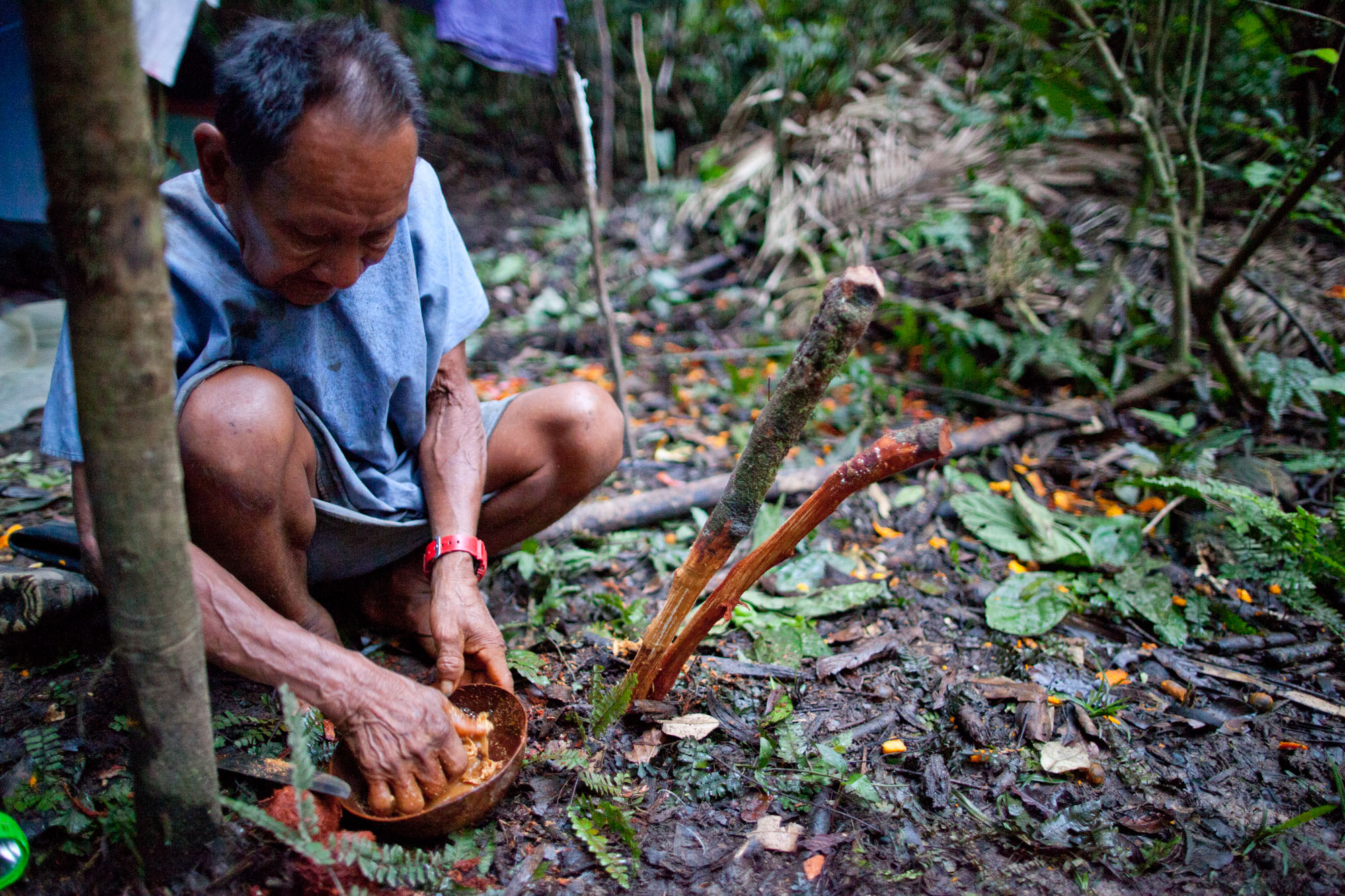
Siekopai elder Delfin Payaguaje prepares a gourd Yoco, a highly caffeinated woody vine of the Sapindaceae family, before a trip into the forest to collect plants.
The Siekopai also employ a host of plants over the course of their lives to maintain acute vision. Jimi and Ribaldo interview Jonathan Piaguaje, a father of 3 in his early twenties, that learned about the plants from his recently deceased grandmother. He points out an understory orchid with bright red, lip-like flowers, breaks off a leaf tip, nibbles and says, “Ñako’ëco”. He collects the leaves and flower petals and places them in a small flask for the night. The following morning, at first light, they observe Jonathan patiently collecting dew from leaves and pouring it into the plant mixture. Once prepared, Jonathan’s father-in-law, Marcelo Payaguaje, applies droplets of the liquid with a swab of cotton to each family member’s eye- a procedure that will be repeated each day for about a week. Jonathon explains that for an even more effective cataract preventive, the black, liquid pigment from a premature wing-feather of the turkey-like spinx’s curassow should be added to the mixture.
Beyond teaching the proper usage of the plant, Jonathan shares other teachings imparted to him by his grandmother on how to maintain good eyesight; “she would tell me to be careful not to walk into the mesh of spider webs that hang across the hunting paths …over time they blur the eyes…, and no weaving hammocks in poor light…, avoid looking into the sun’s reflection off the water’s surface, especially in the black water lagoons.” With a tone of sadness and regret, Jonathan admits to what he says is his greatest error in life: “For some reason I always imagined I had my whole life to learn from my grandmother…she was a true expert on everything about the forest and how to live within it… a source of endless knowledge and stories, and then she vanished…From here on I’ll mostly have to learn on my own I guess”.
During their excursions into the deep woods with the elders, Jimi and Ribaldo continued to interview, document and experience the incredible depth and detail of even some of the rarest and obscure forest illnesses and their plant cures. During a canoe expedition, Ribaldo’s grandfather, Marcelo points to a rare zig-zag, ladder-like epiphyte hanging from a mossy branch above a stream. He then proceeds to remove his boot and reveal a deep, glossy scar from childhood on his foot that was caused by the flesh-decomposing, milky exude of a rare terrestrial planarian or flatworm. Feared as one of the more difficult-to-cure ailments of the forest, Marcelo prepares a poultice from the epiphyte, encloses it in a leaf and roasts it on the fire. “When I was a child my aunt cured me with this plant, if not for her, I might have lost my toes or perhaps more, as I have seen with other bouts when left unattended.”
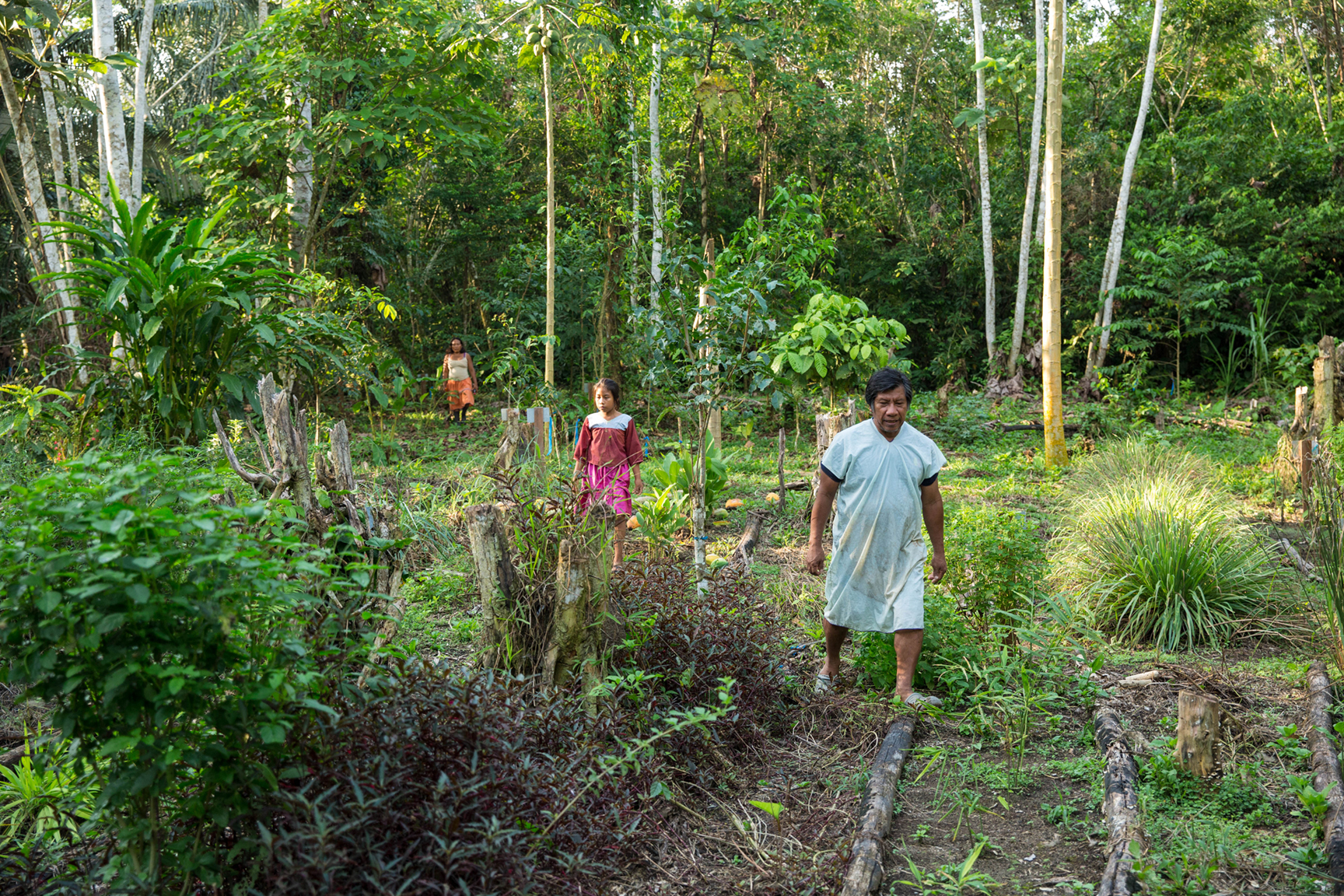
Fanny Payaguaje (far left)- the garden’s curator- daughter, and husband Colon Piaguaje during a visit to the medicinal plant garden in Sewaya.
Toward the end of their documentation, Jimi and Ribaldo accompanied the village elementary school children for a visit to the garden. Here, Fanny Payaguaje, one of the principle spearheads and curator of the garden initiative, explains another important category of plants being collected and propagated. These can best be referred to as ancestral cultivars, or plants that are not found in the forest, but rather have been passed along from generation to generation.
Fanny begins by telling the children the origin myth of Ñumi, one of the most sacred plants of the Siekopai, attained by a long-forgotten Siekopai shaman during an ayahuasca-induced journey into a metaphysical world. She explains that the leaves placed in a gourd of water serve to “capture” the incantation or icaros of the shamans- a botanical vector of sorts used to transmit the verbal blessings from healer to patient. Next, the children huddle together around kuujimaña, a piperaceae, and also of a mysterious origin. She picks a handful of leaves, pounds them into a poultice and offers a sip to each child. She then demonstrates how the poultice is rubbed onto the joints of the arms and legs to ensure they grow strong, and to avoid the inevitable weariness and pains of an exceptionally demanding physical life within the rainforest—a life of long hunts, climbing trees, running after wild boar, carrying heavy loads of wild game and timbers over hills and through swamps. The children laugh and begin to accuse the two documentary makers of not having been cured as children with this plant, and tease them of panting and sweating just from carrying little cameras and microphones through the forest.
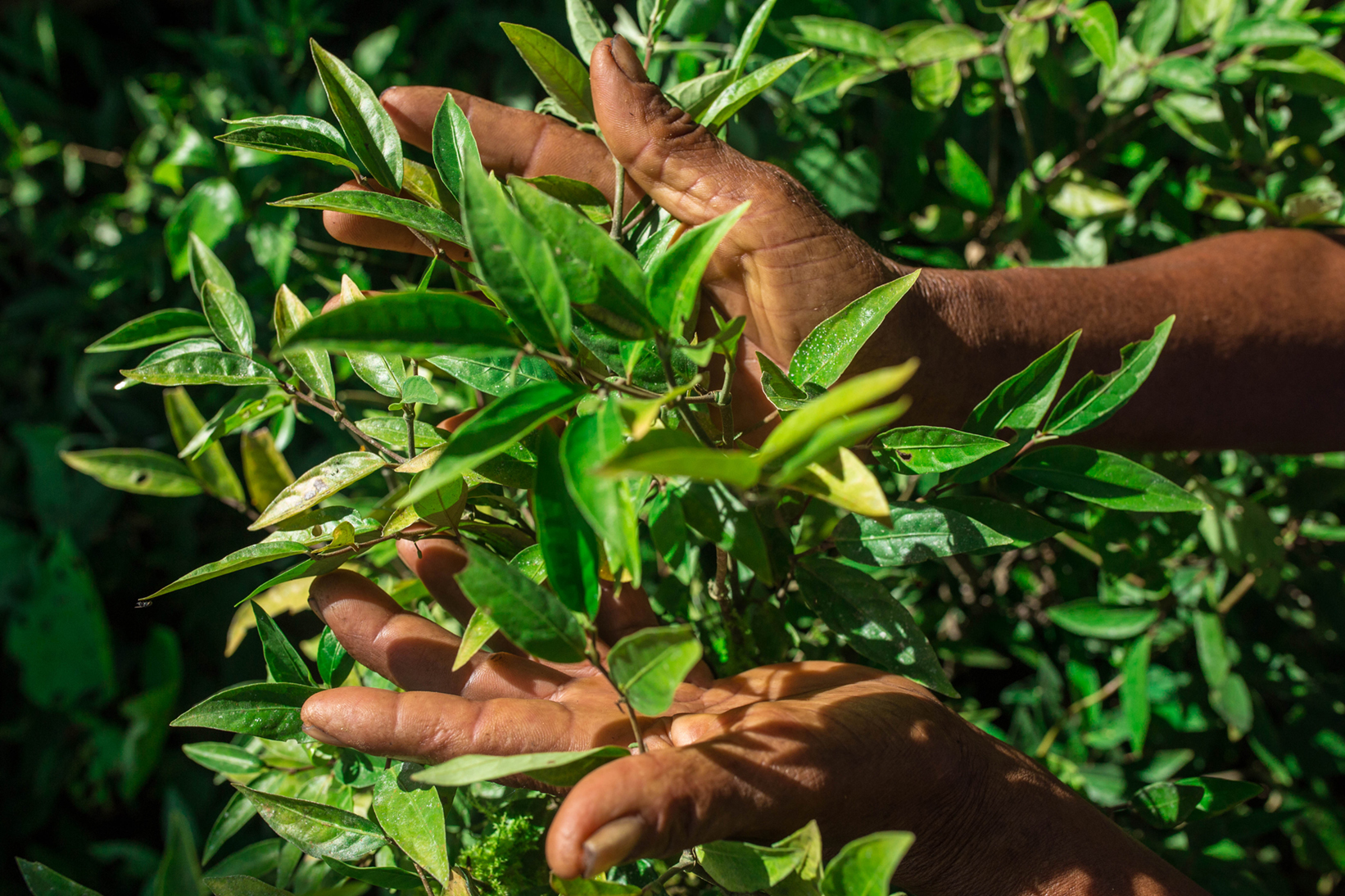
The mysteriously attained Ñumi plant and one of the most important ancestral cultivars of the Siekopai people used to “capture” the healing chants of shamans during ayahuasca ceremonies.
Over the course of a year, Jimi and Ribaldo’s effort led to the production of a 15-volume set of fully edited video documentaries that detail the vast treasury of Siekopai plant knowledge. For them this knowledge will live on, not just in digital format, but also in their minds, bodies and soul.
More importantly, they see other Siekopai youth learning the knowledge through social media and their website. They also see a growing interest among other youth to learn more from the elders about other aspects of their culture. It seems ironic, perhaps, that these two youth see the outside world, with all of the imminent threats it imposes, as a potential catalyst for its preservation. That with each “like” on Facebook, a bit more pride is being circulated through the village–a pride that is not only inspiring similar experiential documentation of their ancient culture, but also a pride that is essential in defending against the destruction of these last remaining people and places.




